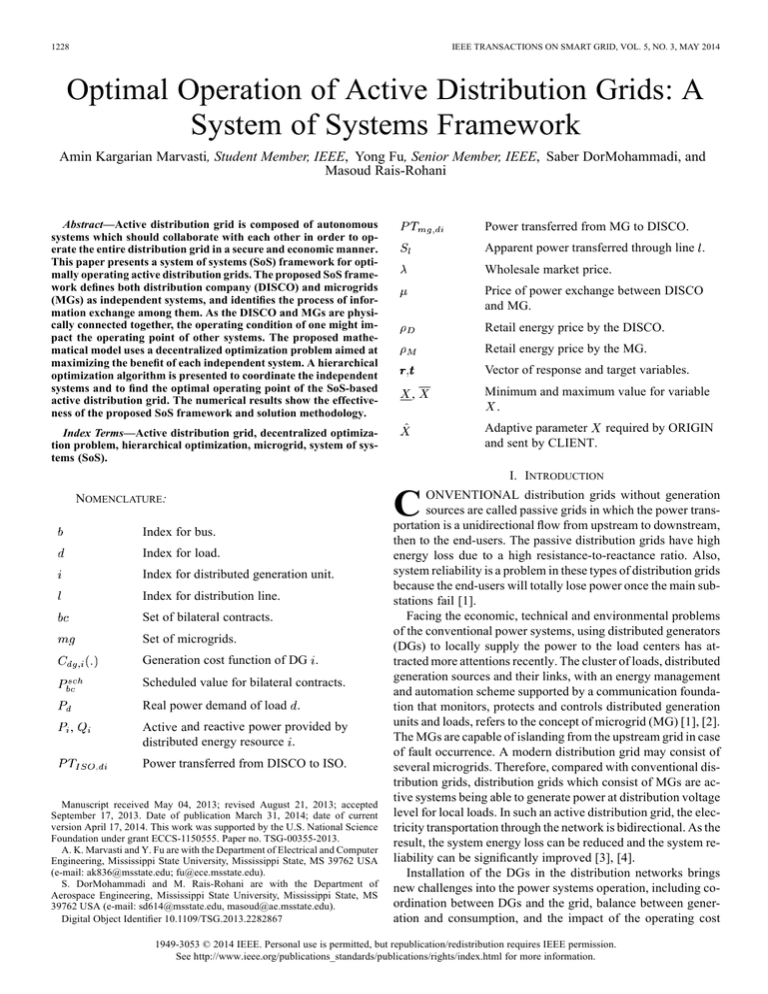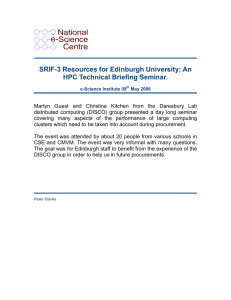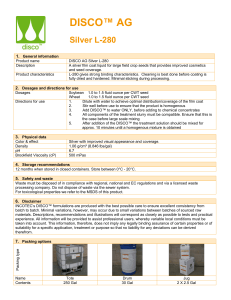Optimal Operation of Active Distribution Grids: A System of Systems
advertisement

1228 IEEE TRANSACTIONS ON SMART GRID, VOL. 5, NO. 3, MAY 2014 Optimal Operation of Active Distribution Grids: A System of Systems Framework Amin Kargarian Marvasti, Student Member, IEEE, Yong Fu, Senior Member, IEEE, Saber DorMohammadi, and Masoud Rais-Rohani Abstract—Active distribution grid is composed of autonomous systems which should collaborate with each other in order to operate the entire distribution grid in a secure and economic manner. This paper presents a system of systems (SoS) framework for optimally operating active distribution grids. The proposed SoS framework defines both distribution company (DISCO) and microgrids (MGs) as independent systems, and identifies the process of information exchange among them. As the DISCO and MGs are physically connected together, the operating condition of one might impact the operating point of other systems. The proposed mathematical model uses a decentralized optimization problem aimed at maximizing the benefit of each independent system. A hierarchical optimization algorithm is presented to coordinate the independent systems and to find the optimal operating point of the SoS-based active distribution grid. The numerical results show the effectiveness of the proposed SoS framework and solution methodology. Power transferred from MG to DISCO. Apparent power transferred through line . Wholesale market price. Price of power exchange between DISCO and MG. Retail energy price by the DISCO. Retail energy price by the MG. Vector of response and target variables. , Adaptive parameter required by ORIGIN and sent by CLIENT. Index Terms—Active distribution grid, decentralized optimization problem, hierarchical optimization, microgrid, system of systems (SoS). NOMENCLATURE: Index for bus. Index for load. Index for distributed generation unit. Index for distribution line. Set of bilateral contracts. Set of microgrids. Generation cost function of DG . Scheduled value for bilateral contracts. Real power demand of load . , Active and reactive power provided by distributed energy resource . Power transferred from DISCO to ISO. Manuscript received May 04, 2013; revised August 21, 2013; accepted September 17, 2013. Date of publication March 31, 2014; date of current version April 17, 2014. This work was supported by the U.S. National Science Foundation under grant ECCS-1150555. Paper no. TSG-00355-2013. A. K. Marvasti and Y. Fu are with the Department of Electrical and Computer Engineering, Mississippi State University, Mississippi State, MS 39762 USA (e-mail: ak836@msstate.edu; fu@ece.msstate.edu). S. DorMohammadi and M. Rais-Rohani are with the Department of Aerospace Engineering, Mississippi State University, Mississippi State, MS 39762 USA (e-mail: sd614@msstate.edu, masoud@ae.msstate.edu). Digital Object Identifier 10.1109/TSG.2013.2282867 Minimum and maximum value for variable . C I. INTRODUCTION ONVENTIONAL distribution grids without generation sources are called passive grids in which the power transportation is a unidirectional flow from upstream to downstream, then to the end-users. The passive distribution grids have high energy loss due to a high resistance-to-reactance ratio. Also, system reliability is a problem in these types of distribution grids because the end-users will totally lose power once the main substations fail [1]. Facing the economic, technical and environmental problems of the conventional power systems, using distributed generators (DGs) to locally supply the power to the load centers has attracted more attentions recently. The cluster of loads, distributed generation sources and their links, with an energy management and automation scheme supported by a communication foundation that monitors, protects and controls distributed generation units and loads, refers to the concept of microgrid (MG) [1], [2]. The MGs are capable of islanding from the upstream grid in case of fault occurrence. A modern distribution grid may consist of several microgrids. Therefore, compared with conventional distribution grids, distribution grids which consist of MGs are active systems being able to generate power at distribution voltage level for local loads. In such an active distribution grid, the electricity transportation through the network is bidirectional. As the result, the system energy loss can be reduced and the system reliability can be significantly improved [3], [4]. Installation of the DGs in the distribution networks brings new challenges into the power systems operation, including coordination between DGs and the grid, balance between generation and consumption, and the impact of the operating cost 1949-3053 © 2014 IEEE. Personal use is permitted, but republication/redistribution requires IEEE permission. See http://www.ieee.org/publications_standards/publications/rights/index.html for more information. MARVASTI et al.: OPTIMAL OPERATION OF ACTIVE DISTRIBUTION GRIDS: A SYSTEM OF SYSTEMS FRAMEWORK of the DGs on the electricity market price [3]. In order to analyze the effect of operation of DG units on energy loss and the ability of distribution grids in load supply, a fuzzy evaluation tool was proposed in [5]. Reference [6] presented a centralized optimization model for a short-term distribution system operation considering incremental contribution of DG units to distribution system loss. Reference [7] introduced a two-staged optimization model for a short-term scheduling of energy resources in distribution grids. This model is a nonlinear multi-objective optimization problem that takes into account operation requirements and network constraints. To ensure stable operation of MGs, an economic dispatch problem was formulated in [8] to find the power dispatch of DGs for optimal operation of MGs. The objective of the problem is to minimize fuel cost during the grid-connected operation. A multi-agent system for real-time operation of a MG was addressed in [9] which mainly focuses on generation scheduling and demand side management. An algorithm for reactive power programming of a MG was addressed in [10]. This algorithm is a four-stage multi-objective optimization that minimizes the power loss and maximizes reactive power reserve and voltage security margin. Note that in active distribution grids, the DISCO and MGs, which might be run as autonomous entities, should collaborate with each other for an optimal operation of the entire distribution system. As these entities are independent systems, the competition and collaboration relationship among them can be represented by the concept of system of systems (SoS) which refers to a group of components that are separately considered as systems that are both administratively and operationally self-governing [11]. In such an SoS, the dispatching and operational independence of each system should be respected. Generators, loads and network information of an autonomous system are usually considered commercially sensitive. Therefore, using centralized optimization algorithms which need all the information of the autonomous systems, might not be an appropriate way to find the optimal operating point of an active distribution grid. In this paper, a framework is established based on the concept of SoS to model the DISCO and MGs as independent systems. For collaboration between the independent systems, the concept of CLIENT and ORIGIN systems, the process of information exchange between the independent systems and the relationship table are discussed. A decentralized optimization model is formulated to maximize the benefit of each individual and autonomous system while satisfying the security constraints associated with DISCO’s and MGs’ operations. Considering the issue that the operating point of a system in the SoS may influence the operating point of the other independent systems, a hierarchical optimization algorithm is presented to coordinate the independent systems and to find the optimal operating point of the SoS-based active distribution grid. The proposed SoS-based decentralized optimal power flow (OPF) is a procedure in which each independent utility or operator only deals with its own information and schedules for its own internal area and crossing borders with other systems. Thus, only a limited amount of information is exchanged among the operators of different systems. The rest of paper is organized as follows. The active distribution grid is defined as a system of systems in Section II. The proposed decentralized optimization model and solution process 1229 Fig. 1. Power flow and cash flow directions in passive distribution networks. Fig. 2. Power flow and cash flow directions in active distribution networks. are carried out in Section III. Numerical testing results are presented and analyzed in Section IV. The concluding remarks are provided in Section V. II. ACTIVE DISTRIBUTION GRID AS A SYSTEM OF SYSTEMS In passive distribution networks, the DISCO, which is responsible for the secure operation and control of the distribution grids, purchases electricity from the wholesale energy market and sells it to the end-users. Fig. 1 shows the power flow and cash flow directions in passive distribution networks. Compared with the conventional distribution networks, the distribution grids, which encompass several MGs, are active systems being able to produce the electric power. Power flow and cash flow directions between the entities in active distribution networks are shown in Fig. 2, which is more complicated than that in the passive distribution systems. The MGs might be independent systems with their own operation and control regulations, and they are connected to the DISCO that is a higher-level autonomous system to coordinate the MGs. When all the systems collaborate together to improve security and reliability of the entire distribution network, each independent system intends to increase its own benefit. Hence, the operation and control schemes of active distribution grids can be designed and implemented based on the concept of SoS. An SoS is described as an incorporation of task-oriented or dedicated systems in a unique system in which its components: 1) collect their own resources and capabilities to construct a more complex system that has more capability and performance than simply the sum of its basic systems, and 2) are able to independently perform valid functions in their own right and continue to work to fulfill those purposes when separated from the overall system [11]. Different areas are identified within the SoS research area [12], [13]. One of the most important issues in the SoS is to find the optimal operating point of the networks including interacting systems that work together to optimize various objectives while satisfying the constraints of the systems [14]. To achieve this goal, there should be suitable models 1230 and approaches for communicating and transferring information among these systems. In this paper, an SoS framework for operating active distribution grid is studied. In this framework, as an autonomous system, the DISCO is responsible for the distribution grid operation. The DISCO operates its own DGs, purchases electricity from the wholesale market and even MGs, and then sells it to the down-stream customers. The DISCO is also able to sell its excess energy to the wholesale market. Each MG is a self-operated entity which aims at maximizing its own benefit. According to different factors or operational situations, the MG operator may decide to buy/sell energy from/to the DISCO. Thus, an MG may play the role of either the customer or the power provider from the viewpoint of the DISCO. A. Required Data to Model Behaviors of Independent Systems To model the behavior of an independent system, various types of data and information are required. In general, constant values (e.g., reactance of the lines) and decision (control and state) variables (e.g., power produced by DGs and voltage of the buses) are two types of the required data. An autonomous system defines the value of its local decision variables according to the different conditions to improve its performance and societal advantage. In the SoS framework, two other types of data are introduced here named adaptive parameters and shared variables. The adaptive parameters are those parameters that are provided for an autonomous system by other autonomous systems and have a fixed value in a certain period of system operation. However, these parameters may have different values in different intervals of system operation. For example, the limit of power exchange with MGs, which is specified by DISCO for a specific hour, is an adaptive parameter for the MGs. Receiving the adaptive parameters, an independent system is able to build its own local optimization problem. The shared variables are those decision variables that are common between at least two independent systems and link the systems together. This type of variables might be controlled by certain independent systems. In fact, the shared variables model the impact of the operating condition of the independent systems on each other. For example, the power exchange between the DISCO and an MG is a shared variable between these two independent systems, being controlled by both DISCO and MG. B. CLIENT and ORIGIN Systems An autonomous system may send request signals to the other independent systems and ask them for the values of the adaptive parameters or shared variables. The system that needs to receive information from another system is referred to as a CLIENT system. ORIGIN stands for a system that receives a request signal and responds to the signal by sending the values of some adaptive parameters or shared variables to another system. For example, as the CLIENT, the MG sends a request signal to the DISCO (the ORIGIN), and asks for the price of power exchange between MG and DISCO. Also, the DISCO could be the CLIENT of the information of power exchange limits which is defined by each MG as the ORIGIN. IEEE TRANSACTIONS ON SMART GRID, VOL. 5, NO. 3, MAY 2014 C. Data Flow Process Between the Systems For transferring the values of the adaptive parameters and shared variables between the ORIGINs and CLIENTs, each autonomous system requires interaction and communication with other systems in the SoS. To specify the details, a Relationship Table shown in Fig. 3 subdivides each system to its constituent parameters, including the constant values, decision variables, adaptive parameters and shared variables, and specifies the ORIGIN (o) and CLIENT (c) of the adaptive parameters and shared variables. Three types of data transferred between the DISCO and MGs are recognized as follows: Type 1) DISCO specifies the adaptive parameters, such as price of selling/buying energy to/from the MGs, limit of power exchange with the MGs, and bilateral contracts information, and sends them to the MGs. In this case, DISCO is the ORIGIN of data and MGs are the CLIENTs. Type 2) A certain MG defines adaptive parameters, such as the limit of power exchange with the DISCO and bilateral contracts information, and sends them to the DISCO and other MGs. In this case, the certain MG is the ORIGIN of data, whereas DISCO and the other MGs are the CLIENTs. Type 3) The DISCO specifies the shared variables, such as power transferred between the DISCO and the MG, and sends it to the MG. In this case, DISCO is the ORIGIN of data and MG is the CLIENT. Conversely, the MG determines the shared variables and sends it to the DISCO. III. DECENTRALIZED MATHEMATICAL OPTIMIZATION MODEL Usually, a centralized optimization problem is solved to find the optimal operating point of distribution grids. The goal could be to maximize the overall benefit of the grid while meeting the operational constraints of the grid, such as bus voltage and line capacity limits. However, as both DISCO and MGs might be independent systems in an active distribution grid, exchanging information of generators, loads and network of an autonomous system is usually considered commercially sensitive. Therefore, such a centralized optimization model is no longer an appropriate approach to operate the grid. In this section, a decentralized optimization model is formulated to determine the optimal operating point of the SoS-based active distribution grid. The proposed model is solved by a hierarchical optimization algorithm taking into account the economic and technical issues raised in the independent microgrids and distribution company operations. In the following subsections, a general hierarchical optimization model is explained based on compact formulations. Then, the optimization problem of independent DISCO and MGs, and the interactions among them are formulated and discussed in detail. A. Hierarchical Two-Level Optimization In this section, an algorithm is presented to decompose the optimization problem associated with an active distribution grid and to build a hierarchical two-level optimization model for its MARVASTI et al.: OPTIMAL OPERATION OF ACTIVE DISTRIBUTION GRIDS: A SYSTEM OF SYSTEMS FRAMEWORK 1231 Fig. 3. Relationship table for an active distribution grid. Assume the overall objective function and constraints can be decomposed into separate elements, such as , and The original all-at-once optimization problem described in (1) can be rewritten in the following form [16]. Fig. 4. Active distribution grid in the form of a two-level SoS structure. implementation. Consider the following general all-at-once optimization problem (1) for an active distribution grid aiming at minimizing the total operating cost (or maximizing the overall benefit) of the grid [15]. (1) where vector x represents all the decision (i.e., control and state) variables, F is the overall objective function of the system, vector G represents all the inequality constraints (i.e., bus voltage and line capacity limits, generation limits of DGs), and vector H represents all the equality constraints (i.e., nodal active and reactive power balance equations). A two-level SoS-based structure is illustrated in Fig. 4 to decompose the active distribution grid into independent systems. The DISCO is the only system in the first level and MGs connected to the DISCO are located in the second level. The DISCO may be called as the system element and MGs as the subsystem elements. As all independent subsystems are connected through one system element, the optimal operating point of the SoS-based active distribution grid can be obtained using hierarchical optimization methods. The process of modeling a hierarchical two-level optimization problem is briefly explained below. (2) is the where the subscript mn denotes system in level , vector of local decision variables for system , is the local objective function, and are vectors of local inequality and equality constraints related to independent system in level , is the set of systems located in level , is the vector of target variables shared between system in level and the related system in level , and is the set of systems in level that have shared variables with system mn. In (2), the vector represents the shared variables because of the coupling among the individual systems. To decompose the objective functions and constraints related to each independent system, response copies are introduced. Knowing the vector of targets, , the consistency constraints expressed as (3) can be used to make the formulation in (2) separable. Introducing the penalty function along with (3) leads to a relaxed formulation of (2) expressed as 1232 IEEE TRANSACTIONS ON SMART GRID, VOL. 5, NO. 3, MAY 2014 (4) Therefore, the optimization problem presented in (4) can be further decomposed into the local optimization problems corresponding to the independent systems. The optimization model for system mn is formulated as (5) models the impact of the operating where the term of conditions of the other independent systems on system mn. Using the exponential penalty function formulation proposed in [16] for modeling the term, the optimization problem in element mn is given as Fig. 5. Modeling target and response variables in both Disco and MGn. using these shared variables, which are regarded as target variables in the DISCO’s optimization problem, and response variables in the ’s optimization problem. When the power is transferred from to DISCO, it is a pseudo generator for DISCO and a pseudo load for MG. However, when the power is transferred from DISCO to , it is a pseudo generator for MG and a pseudo load for DISCO. C. Optimization Problem Model for Individual Systems (6) where and are vectors of multipliers which should be updated during the iterative solution process. As an important aspect, since the exponential penalty function is second-order differentiable, the optimization problem can be solved using any second-order method that requires the calculation of the Hessian matrix. The optimization problem in (6) is for a system/subsystem element in the hierarchical structure. However, before discussing its solution process, a detailed optimization problem is formulated in the following subsections for each independent system of the SoS-based active distribution grid, in which both target and response variables, as shared variables between the systems, are identified. B. Modeling Target and Response Variables The target and response variables used in the proposed twolevel optimization problem are shown in Fig. 5(a). Consider the DISCO is connected to through the line between buses and as shown in Fig. 5(b). Buses and , and the linking line are modeled together as the shared connection between DISCO (level 1) and (level 2). The shared connection is taken into account in the optimization problem of both DISCO and as shown in Figs. 5(c) and 5(d), respectively. In order to address the shared connection in the hierarchical two-level optimization, the design (or state) variables influencing the power transferred through the line of shared connection are defined as the shared variables between these two independent systems, DISCO and . The power exchange between DISCO and can be calculated In this section, the local optimization problem for each system, MGs and DISCO, is formulated, and the sequential quadratic programming (SQP) technique is used to solve the corresponding subproblems. 1) Optimization Problem for MGs: To formulate the MG optimization model, (as a CILENT) needs to receive the values of the adaptive parameters including price of power exchange with DISCO , bilateral contract information , and limit of power exchange with DISCO ( and ) from the DISCO and other MGs (as ORIGINs). The MG optimization problem is formulated as (7) The first two terms in (7) are the generation cost of DG units and the revenue of selling the electric power to the end-users. In the third term, when is positive, the MG is selling power to DISCO, but when it is negative, the MG is purchasing power from DISCO. In this term, when the power is transferred from MG to DISCO, is positive, otherwise it is negative. And, for the bilateral transactions that provides power to the other systems, is positive; otherwise, is negative. As the bilateral transactions are based on long term contracts, only the cost of is included in the short-term scheduling. The last term in (7) is the penalty function related to the shared variables. Notice that in the penalty function, the response variables need to be MARVASTI et al.: OPTIMAL OPERATION OF ACTIVE DISTRIBUTION GRIDS: A SYSTEM OF SYSTEMS FRAMEWORK determined, but the values of target variables are received from the DISCO. To meet the operational security of the MG system, the following constraints should be satisfied. 1) Nodal active and reactive power balances A compact form of non-linear full load flow equations is shown in (8) and (9). 1233 penalty function. is treated as the vector of design variables while is treated as a constant term in (16). (8) (9) (16) 2) Generation capacity limits of the DG units (10) (11) 3) Bus voltage limits (12) 4) Distribution lines capacity limits The apparent power of all the lines including the line connecting MG to DISCO must be within the limits. (13) 5) Limits of power exchange between DISCO and MG In the SoS-based active distribution grids scheduling, MG and DISCO, as the independent systems, may have different restrictions for the amount of power exchange between them. Thus, in addition to (13), the following constraint is taken into account. In (16), the first and second terms are the generation cost of DG units and cost of power transferred from MGs to DISCO, the third and fourth terms are revenue of selling electric power to the end-users and transmission system (e.g., ISO), respectively. The last term is the penalty function related to the shared variables with MGs. Notice that in (16), when power is transferred from MG to DISCO, is positive; otherwise, it is negative. Also, is negative when the DISCO commits power for another system based on long term bilateral transactions; otherwise, it is positive. is positive when the power is transferred from ISO toward DISCO; otherwise, it is negative. Similarly, the following constraints should be included in this optimization model. 1) Nodal active and reactive power balances (17) (18) 2) Generation capacity limits of the DG units (19) (20) (14) where the adaptive parameters (constant for an specific period) and are minimum and maximum allowable values for the power exchange between MG and DISCO from the DISCO’s perspective; and and are minimum and maximum acceptable values from the MG’s perspective. 6) Bilateral contract transaction restrictions An MG may have bilateral contracts with DISCO and the other MGs. The constraint (15) guarantees that the bilateral constraints are satisfied. For a specific period, the values of bilateral contracts (adaptive parameters) are known. Thus, only one of the following constraints should be applied for that operation period: (15) 2) Optimization Problem for DISCO: Receiving the adaptive parameters , , from the MGs (as ORIGINs), the following optimization problem is formulated to find the optimal operating point of the DISCO (as a CLIENT). The response variables received from the MGs are used to model the 3) Bus voltage limits (21) 4) Distribution lines capacity limits (22) 5) 5.1) Limits of power exchange between DISCO and ISO (23) 6) 5.2) Limits of power exchange between DISCO and MG (24) and where the adaptive parameters are respectively the minimum and maximum allowable values for the power exchanged between MG and DISCO from the MG’s perspective; and the adaptive parameters and are respectively the minimum and maximum acceptable values from the DISCO’s perspective. 1234 IEEE TRANSACTIONS ON SMART GRID, VOL. 5, NO. 3, MAY 2014 7) Bilateral contract transaction restrictions The following constraint satisfies the bilateral contracts that the DISCO may have with the MGs. (25) D. Solution Procedure Fig. 6 illustrates the solution procedure of the proposed hierarchical optimization algorithm which determines the optimal operating point of all independent systems in the SoS-based active distribution grid. This algorithm has two iteration loops, inner and outer, which are explained as follows. Step 1: Set the iteration index for the inner loop and for the outer loop, and choose initial values for , and . Step 2: Set . Solve the optimization problem (7)–(15) for each MG with as the design varifrom the previous itables and the values of eration. Step 3: Solve the local optimization problem (16)–(25) for DISCO with as the design variables and the values of obtained in Step 2. Step 4: Use (26) and (27) to check the inner loop convergence. If they are not satisfied, return to Step 2 for the next iteration; otherwise, go to Step 5. (26) (27) Step 5: Check the following necessary-consistency (28) and sufficient (29) stopping criteria for the outer loop. If they are not satisfied, got to Step 6; otherwise, the converged optimal result is obtained and the solution procedure stops. Necessary-consistency condition: (28) Sufficient condition: (29) Step 6: Set and and update the values of multipliers using (30) and (31). (30) (31) Step 7: Set , and return to Step 2. Note that in practice the additional stopping criteria (32) and (33) may be introduced to the inner and outer loops in order to avoid facing the dead loop. (32) (33) Fig. 6. Flowchart of the solving process. where and are maximum allowable number of inner and outer loop iterations, respectively. IV. NUMERICAL RESULTS An active distribution grid is shown in Fig. 7. This grid includes one DISCO and three MGs. The system description of the DISCO and the MGs are summarized in Table I. Assume that the resistance and reactance of all lines are 0.05 and 0.1 p.u., respectively; the capacity of the lines is 7 MW; the prices and are 50 $/MWh, the prices and are 25 ct/KWh, the limits of power exchange among transmission system (ISO), DISCO , , and are deand MGs, fined as , 50MW, and 10MW, respectively. The reference bus is bus in DISCO. The range of voltage of the buses is 0.9–1.1 p.u. The simulations are implemented on a PC with Intel(R) Core(TM) i7 with two processors at 2.8GHZ. To test the effectiveness of the proposed SoS framework for operating the active distribution grid, the following three cases are studied: Case 1: Only MG1 is connected to the DISCO grid Case 2: All three MGs are connected to the DISCO grid Case 3: Sensitivity analysis for the inner loop convergence criterion 1) Case 1: The active distribution grid used in this case consists of the DISCO and MG1. According to the SoS concept, MARVASTI et al.: OPTIMAL OPERATION OF ACTIVE DISTRIBUTION GRIDS: A SYSTEM OF SYSTEMS FRAMEWORK 1235 TABLE II ACTIVE (MW) AND REACTIVE (MVAR) POWER PROVIDED BY DGS TABLE III BUS VOLTAGE AND ANGLE OF THE SYSTEMS Fig. 7. The test case active distribution grid. TABLE I ACTIVE DISTRIBUTION SYSTEM DESCRIPTION Fig. 8. Updating process of power exchange between DISCO and MG1. the entire grid is separated into two independent systems, one for DISCO and one for MG1. The initial value for and and convergence thresholds , and are set to 0.01, 0.001 and 0.001, respectively. Fig. 8 shows the amount of power exchange between DISCO and MG1 in each iteration (outer loop). After 8 outer loop iterations, the converged optimal power exchange is obtained. The total calculation time is 34 seconds. The decentralized OPF results, including active and reactive power provided by generation sources and bus voltages and angles, are listed in Tables II and III, respectively, which is very close to the conventional centralized results. The maximum relative errors between the centralized and the decentralized results for active and reactive power provided by generation sources, and bus voltages and angles are 3%, 1.5%, 0.9% and 3%, respectively. Notice that in Table II, the negative value for the exchanged power between DISCO and transmission system indi- cates that the DISCO is selling energy to the wholesale market. Using the centralized model, the power transferred from DISCO to transmission system is 5.67MW, the power exchange between DISCO and MG1 is 3.89MW, and the total benefit of distribution grid is $1414. Applying the proposed SoS framework, the DISCO is selling 5.68 MW to the wholesale energy market, the power exchange between DISCO and MG1 is 3.93MW, and the benefit of DISCO and MG1 are $832.8 and $580.6 (total benefit of the SoS is $1413.4), respectively. Note that the relative errors for the power exchange between DISCO and wholesale market, the power exchange between DISCO and MG1, and total benefit of the grid, are 0.17%, 1% and 0.04%, respectively. 2) Case 2: In this case, the proposed SoS framework is applied on an active distribution grid in which one independent DISCO is linked with three independent MGs as shown in Fig. 8. Again, based on the SoS concept, the entire grid is separated into four different independent systems. Set the initial values , , and , and pick the values 0.01, 0.001, and 0.001 for the convergence thresholds , , and , respectively. The amount of power exchange between the DISCO and three MGs in each outer loop iteration is shown in Fig. 9. The algorithm converges after 11 iterations, and the total calculation time is 98 seconds. The scheduled active and reactive power generations of DGs are summarized in Table IV. In order to validate the results of the proposed decentralized algorithm, the active and reactive power outputs of the generation sources obtained from the conventional centralized algorithm are listed in Table IV. The maximum relative errors between the centralized and the decentralized results for active and reactive power outputs are 2.7% and 4%, respectively. Also, the optimal power exchange between DISCO and three MGs, and total benefit of each independent system are presented in Table V. Note that 1236 IEEE TRANSACTIONS ON SMART GRID, VOL. 5, NO. 3, MAY 2014 TABLE V AMOUNT OF POWER EXCHANGE AND TOTAL BENEFIT OF EACH SYSTEM TABLE VI IMPACT OF VARIATIONS ON THE PERFORMANCE OF THE ALGORITHM PROPOSED Fig. 9. Power exchange between DISCO and MG (a) 1, (b) 2 and (c) 3. TABLE IV ACTIVE AND REACTIVE POWER PRODUCED BY POWER PROVIDERS the power is transferring from the MGs toward the DISCO. Thus, the DISCO is purchasing energy from the MGs, and the shared lines between the DISCO and the MGs behave as pseudo generations for the DISCO and as pseudo loads for the MGs. In addition, the DISCO is selling the power (9.20 MW) to the wholesale energy market, including the power (9.01 MW) purchased from three MGs plus the power (0.19 MW) generated by its own DGs. The total benefit of the DISCO and the MG1 to 3 are $754.1, $581.1, $750, and $460, respectively, and, thus, the total benefit of the entire active distribution grid is $2545.2. The relative errors for the power exchange between DISCO and wholesale market, the power exchange between DISCO and MGs 1–3, and total benefit of the grid, are 0.44%, 1%, 0.85%, 1.3% and 0.1%, respectively. 3) Case 3: In order to analyze the sensitivity of the solution process to the convergence criterion for the inner loop, Case 1 was repeated using different values for . However, the necessary-consistency and sufficient criteria and are fixed to 0.001 in order to guarantee an acceptable result for all the simulations. Setting different values for and implementing the proposed hierarchical two-level algorithm gives the results shown in Table VI with respect to each value of , including the number of iterations of inner loop and outer loop , the total calculation time , as well as the power exchange between DISCO and MG1 ( from the DISCO’s perspective, and from the MG1’s perspective), and the benefit of the DISCO and MG1. Observe that the number of outer loop iterations, is almost unchanged, but the inner loop iterations and the total calculation time are increased by setting a smaller value for (increasing precision of the inner loop). In other words, the computational cost of the algorithm increases with decreasing . When is 0.1, the difference between and is 0.13%. However, for equal to 0.01–0.00001, that difference is reduced to 0.008%, 0.002%, 0% and 0%, respectively, but the calculation time is increased significantly. The total benefit of the grid is almost the same for all the values of . Comparing the results in Table VI shows that the computational cost of setting equal to 0.01 is slightly more than setting 0.1 for , but it results in more accurate results. Consequently, we have chosen 0.01 for in Cases 1 and 2 to make a trade-off between solution accuracy and calculation effort. V. CONCLUSIONS Nowadays, the power systems are moving toward decomposition into many small-scale smart microgrids which locally support the load centers. Therefore, the SoS-based optimization problems can be very promising for the collaboration between the systems. In this paper, an SoS framework was presented for optimizing the operation of active electric power distribution grids. In this framework, the DISCO and microgrids were regarded as the self-governing systems that were autonomously managed and operated aiming at maximizing their own benefits. The data flow process of communicating and transferring data between the systems were discussed. And the concept ORIGIN and CLIENT systems, adaptive parameters and shared variables were defined in the paper. The decentralized optimization problem was formulated to model the SoS-based operation. And, a hierarchical two-level algorithm was applied to solve the MARVASTI et al.: OPTIMAL OPERATION OF ACTIVE DISTRIBUTION GRIDS: A SYSTEM OF SYSTEMS FRAMEWORK proposed problem and coordinate the operating points of all independent systems. The numerical results showed the accuracy and convergence performance of the proposed SoS framework for operating active distribution grids. REFERENCES [1] S. P. Chowdhury, P. Crossley, and S. Chowdhury, “Microgrids and active distribution networks,” Inst. Eng. Technol., Jul. 2009. [2] R. H. Lasseter, “Microgrids,” in IEEE Power Eng. Soc. Winter Meet., Jan. 2002, vol. 1, pp. 305–308. [3] M. H. Bollen and F. Hassan, Integration of Distributed Generation in the Power System. Hoboken, NJ, USA: Wiley, 2011. [4] A. Khodaei and M. Shahidehpour, “Microgrid-based co-optimization of generation and transmission planning in power systems,” IEEE Trans. Power Syst., vol. 28, no. 2, pp. 1582–1590, May 2013. [5] A. A. S. Algarni and K. Bhattacharya, “Disco operation considering DG units and their goodness factors,” IEEE Trans. Power Syst., vol. 24, no. 4, pp. 1831–1840, Nov. 2009. [6] A. Soroudi, M. Ehsan, R. Caire, and N. Hadjsaid, “Possibilistic evaluation of distributed generations impacts on distribution networks,” IEEE Trans. Power Syst., vol. 26, no. 4, pp. 2293–2301, Nov. 2009. [7] A. Borghetti, M. Bosetti, S. Grillo, S. Massucco, C. A. Nucci, M. Paolone, and F. Silvestro, “Short-term scheduling and control of active distribution systems with high penetration of renewable resources,” IEEE Trans. Power Syst., vol. 4, no. 3, pp. 313–322, Sep. 2010. [8] S. J. Ahn, S. R. Nam, J. H. Choi, and S. I. Moon, “Power scheduling of distributed generators for economic and stable operation of microgrid,” IEEE Trans. Smart Grid, vol. 4, no. 1, pp. 398–405, Mar. 2013. [9] T. Logenthiran, D. Srinivasan, A. Khambadkone, and H. Aung, “Multiagent system for real-time operation of microgrids in real-time digital simulator,” IEEE Trans. Smart Grid, vol. 3, no. 2, pp. 925–933, Jun. 2012. [10] B. Khorramdel and M. Raoofat, “Optimal stochastic reactive power scheduling in a microgrid considering voltage droop scheme of DGs and uncertainty of wind farms,” Energy, vol. 45, pp. 994–1006, 2012. [11] J. M. Held, “The modeling of systems of systems,” Ph.D. dissertation, Univ. Sydney, Sydney, Australia, 2008. [12] W. A. Crossley, System-of-Systems: Introduction of Purdue University Schools of Engineering’s Signature Area. West Lafayette, IN, USA: Purdue Univ.. [13] R. A. Wolf, “Multiobjective collaborative optimization of system of systems,” M.Sc., Mass. Inst. Technol., Cambridge, MA, USA, 2005. [14] M. Jamshidi, System of Systems Engineering: Innovations for the 21th Century, 1 ed. Hoboken, NJ, USA: Wiley, 2008. [15] S. Tosserams, L. F. P. Etman, P. Y. Papalambros, and J. E. Rooda, “An augmented lagrangian relaxation for analytical target cascading using the alternating directions method of multipliers,” Struct. Multidisc Optim., vol. 31, no. 3, pp. 176–189, 2006. [16] S. DorMohammadi and M. Rais-Rohani, “Exponential penalty function formulation for multilevel optimization using the analytical target cascading framework,” Struct. Multidisc Optim., vol. 47, pp. 599–612, 2013. 1237 Amin Kargarian Marvasti (S’10) received the B.S. and M.S. degrees in E.E. from the University of Isfahan and Shiraz University, Iran, in 2007 and 2010, respectively. He is currently working toward the Ph.D. degree in Electrical Engineering at Mississippi State University, Mississippi State University, MS, USA. His research interests include power system optimization and economics, and integration of renewable energies to the grid. Yong Fu (SM’13–M’05) received his B.S. and M.S. in E.E. from Shanghai Jiaotong University, China, in 1997 and 2002, respectively and Ph.D degree in E.E. from Illinois Institute of Technology, Chicago, IL, USA, in 2006. From 2006 to 2009, he was a Senior Research Associate at the Robert W. Galvin Center for Electricity Innovation at Illinois Institute of Technology. Presently, he is an assistant professor in the Department of Electrical and Computer Engineering at Mississippi State University, Mississippi State University, MS, USA. His research interests include power system optimization and economics, renewable energy integration, and critical infrastructure interdependency. Saber DorMohammadi received his B.S. and M.S. in mechanical engineering at Sharif University of Technology, Iran, in 2006 and 2009, respectively. He is currently working toward the Ph.D degree in Computational Engineering at Mississippi State University, Mississippi State University, MS, USA. His research interests include material-product design,multi-level design optimization, and design optimization under uncertainty. Masoud Rais-Rohani is a Professor of Aerospace Engineering and Computational Engineering at Mississippi State University, Mississippi State University, MS, USA. His areas of research include structural and multidisciplinary design optimization, non-deterministic approaches for design under uncertainty, and computational structural mechanics.






